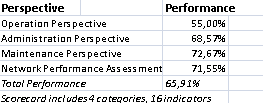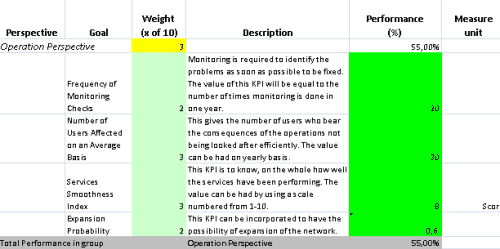 Managing a Network is a cumbersome task for sure as it involves planning, coordinating, allotting and tracking the resources that have been allotted to the network constituents. This mandates the usage of Key performance indicators to track crucial areas like operations, administration, maintenance and network performance.One can analyze 'Operations Perspective' by using indicators like 'Frequency of Monitoring Checks', 'Number of users affected on an average basis', 'Expansion Probability' and 'Services smoothness Index'. Further, Administration of the network can be improved with parameters like 'Resource Allocation Aptness', 'Data collection mechanisms', 'Network Control Aspect' and 'Data collection mechanisms'. Maintenance Perspective can be assessed with indicators like 'Average Equipment Replacement time', 'Performance Gauging', 'Device Configuration Positioning' and 'Number of Access methods used'. Eventually, Network Performance can be obtained by employing metrics like 'Number of network attacks detected', 'Throughput', 'Overhead Percentage' and 'Fraction of Network Bandwidth utilized'.
Managing a Network is a cumbersome task for sure as it involves planning, coordinating, allotting and tracking the resources that have been allotted to the network constituents. This mandates the usage of Key performance indicators to track crucial areas like operations, administration, maintenance and network performance.One can analyze 'Operations Perspective' by using indicators like 'Frequency of Monitoring Checks', 'Number of users affected on an average basis', 'Expansion Probability' and 'Services smoothness Index'. Further, Administration of the network can be improved with parameters like 'Resource Allocation Aptness', 'Data collection mechanisms', 'Network Control Aspect' and 'Data collection mechanisms'. Maintenance Perspective can be assessed with indicators like 'Average Equipment Replacement time', 'Performance Gauging', 'Device Configuration Positioning' and 'Number of Access methods used'. Eventually, Network Performance can be obtained by employing metrics like 'Number of network attacks detected', 'Throughput', 'Overhead Percentage' and 'Fraction of Network Bandwidth utilized'.
Read Why do business professionals choose ready-to-use KPIs? to find out the answers to these questions:

Ideally, you need to have a strategy (in a form of a strategy map) before you start thinking about the ways to measure its execution (KPIs). Don't have a strategy map yet? Use free Strategy Map Wizard to create a strategy map for your current business challenges. The wizard will:
The whole process takes on average 6 minutes. Give it a try right now - it's free.
Managing a network can be a truly cumbersome task in the absence of a performance management tool owing to the several aspects involved in it. Some of the areas that creep into the subject are- Operation, Administration, Maintenance and Provisioning.
Operation is concerned with ensuring that the network is running smoothly. One is supposed to identify problems in as fast manner as possible to prevent the users from getting affected by it. Administration comprises the set of techniques needed to keep-in-place the 'house-keeping' act. In other words, the back-ground activities required to create a clean network scene are put under this arm of 'network management'. Moving on, Maintenance is about plugging the occasional failures, i.e. conduction of repairs to ensure continuous working of the network. Finally, Provisioning is needed for suitable configuring of resources in the network to ensure proper support to the service. A number of technologies are available in the market for network device management.
One is required to look after all of the involved areas along with pulling those together. Organizations have discovered that by using a management strategy like that of BSC (Balanced Scorecard), one can easily get over this difficulty of Network Management.


This is the actual scorecard with Network Management Dashboard and performance indicators. The performance indicators include: operation perspective, frequency of monitoring checks, number of users affected on an average basis, services smoothness index, expansion probability, administration perspective, resource allocation aptness, ‘network control aspect’, data collection mechanisms, data infrastructure potency, maintenance perspective, average equipment replacement time, device configuration positioning, performance gauging, number of access methods used, network performance assessment perspective, overhead percentage, % dip in network attacks, throughput, network bandwidth utilization level